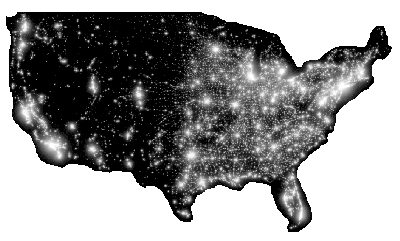Observance of the sixth annual National Dark-Sky Week will take place March 29 through April 4. Founded in 2003 by Jennifer Barlow, the event highlights concern for increasing light pollution, the glow from outdoor lights that washes out the stars in the night sky. Endorsed by the International Dark-Sky Association, American Astronomical Society, and the Astronomical League, event participation grows each year as the public becomes more aware of light pollution and its effects on our everyday lives and the environment.
This year, IDA is encouraging everyone to support the World Wildlife Fund’s Earth Hour, occurring on March 29th. In addition, Lights Out America is now supporting Earth Hour. In past years, various “lights out” campaigns, the WWF, the National Audubon Society, and other organizations have promoted events to protect wildlife and conserve energy. Light pollution is a growing threat, and IDA is encouraged by increased public awareness of the problem and the increasing number of events highlighting it every year.
National Dark-Sky Week seeks to deter light pollution by encouraging better overall outdoor lighting practices. Simply turning off unnecessary lighting for one hour or even a week is only a temporary solution. National Dark-Sky Week seeks to educate the public about lighting fixtures that help reduce light pollution by focusing light downward instead of up into the sky. Also, it is important to always turn off lights when they are not needed and to only use the right amount of light.
As cities continue to grow, so does light pollution through poor planning and misuse of outdoor lighting. While light pollution is detrimental to our ability to observe and enjoy the night sky, it also disrupts the surrounding natural environment, wastes energy, and has the potential to cause health problems. “The only way that National Dark-Sky Week can succeed is if more people participate every year,” says Barlow. “No significant reduction in light pollution can be made unless a great number of people turn off their lights, shield them, and control how bright they are.”
Earth Hour is a global initiative to “turn off the lights” in cities around the world for one hour, starting at 8 p.m. local time on March 29, 2008. Earth Hour will demonstrate that by working together, each one of us can make a positive impact on this global issue. Earth Hour is intended to bring together a diverse group of community, municipal, corporate and non-governmental organizations, to heighten awareness of the impacts of climate change on the world, and to inspire individuals and businesses to take practical action to reduce their own carbon footprint.
These campaigns also encourage the public to attend area star parties or visit a local observatory. But always be careful not to turn out lights that are necessary for public safety, and when going stargazing, carry a red-tinted flashlight and stay in a large group.
Twenty-five cities around the world are confirmed to take part in WWF’s Earth Hour climate change: Aalborg, Denmark; Aarhus, Denmark; Adelaide, Australia; Atlanta, United States; Bangkok, Thailand; Brisbane, Australia; Canberra, Australia; Chicago, United States; Christchurch, New Zealand; Copenhagen, Denmark; Dublin, Ireland; Haifa, Israel; Manila, Philippines; Melbourne, Australia; Montreal, Canada; Odense, Denmark; Ottawa, Canada; Perth, Australia; Phoenix, United States; San Francisco, United States; Suva, Fiji; Sydney, Australia; Tel Aviv, Israel; Toronto, Canada; and
Vancouver, Canada.
As Jennifer Barlow observes, “National Dark-Sky Week is a great opportunity to dust off the old telescope from the attic and share in the wonder of the universe that has been part of the human tradition for thousands of years.”










